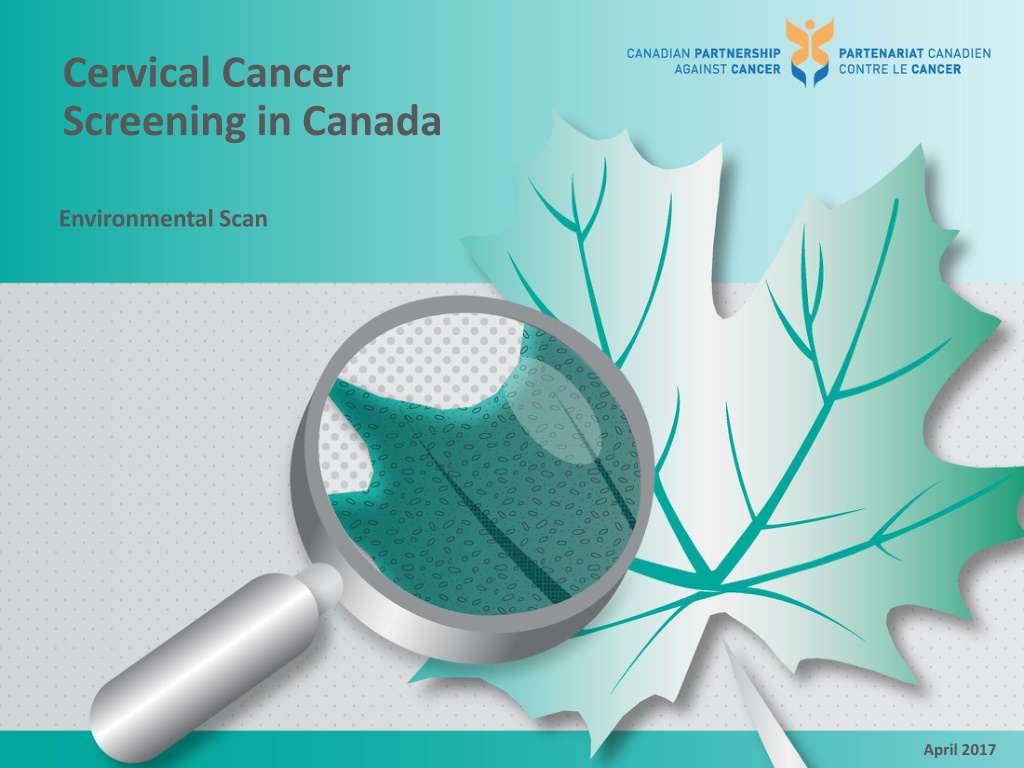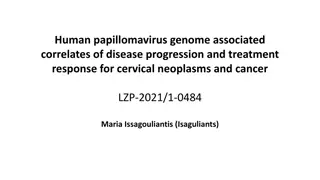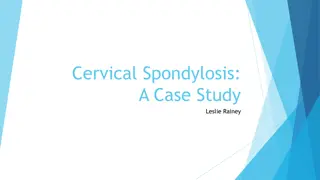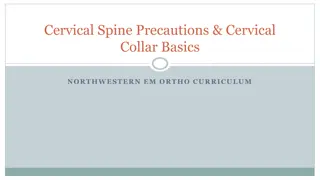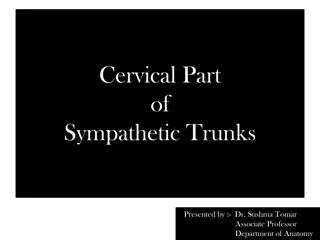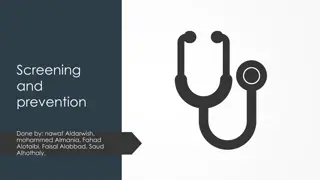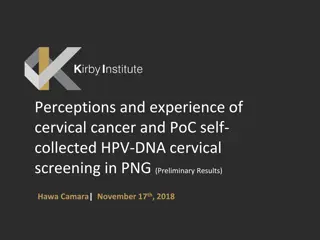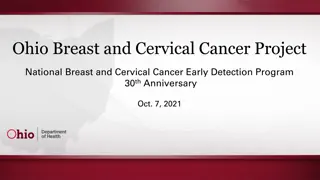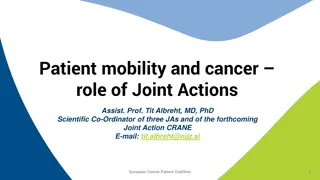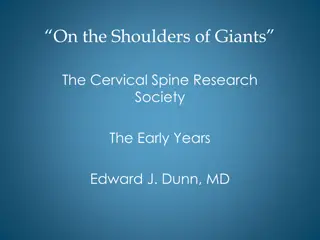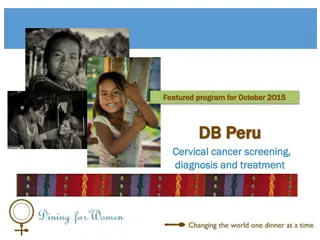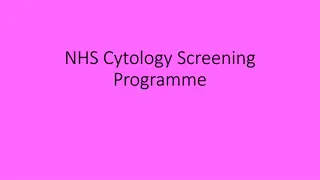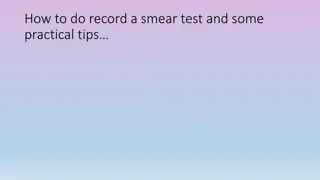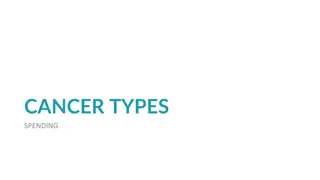Overview of Cervical Cancer Screening Programs in Canada
The Canadian Partnership Against Cancer conducts an annual environmental scan on cervical cancer screening guidelines and strategies across the country. Organized screening programs are available in most provinces, offering services to asymptomatic women at average risk. This scan provides insights into national, provincial, and territorial guidelines, modalities for screening, colposcopy services, and HPV immunization programs. While nine provinces have organized screening programs, opportunistic screening is available in regions without organized programs. Screening typically starts at age 21 or 25 and continues until age 65 to 70 every two to three years, with specific guidelines varying by province.
- Cervical Cancer Screening
- Canadian Partnership Against Cancer
- Guidelines
- HPV Immunization
- Womens Health
Download Presentation

Please find below an Image/Link to download the presentation.
The content on the website is provided AS IS for your information and personal use only. It may not be sold, licensed, or shared on other websites without obtaining consent from the author. Download presentation by click this link. If you encounter any issues during the download, it is possible that the publisher has removed the file from their server.
E N D
Presentation Transcript
Cervical Cancer Screening in Canada Environmental Scan April 2017
Background The Canadian Partnership Against Cancer collects information annually on national, provincial and territorial cervical cancer screening guidelines, strategies, and activities. This scan summarizes the data collected from provincial and territorial screening programs and is intended to provide information on policy and practice. 2
Outline Cervical Cancer Screening Programs and Guidelines Cervical Cancer Screening Pathway Cervical Cancer Screening Programs in Canada Canadian Task Force on Preventive Health Care Guidelines Provincial and Territorial Guidelines Modalities for Cervical Cancer Screening Correspondence Methods for Cervical Cancer Screening Colposcopy Services HPV Immunization Programs in Canada 3
Cervical Cancer Screening Programs and Guidelines Organized cervical cancer screening programs are available in most provinces. These programs screen eligible women who are asymptomatic (no signs or symptoms of cervical cancer present) and at average risk for cervical cancer. There are no organized cervical cancer screening programs in Northwest Territories, Nunavut, Yukon or Quebec but opportunistic screening services may be available through primary care providers. 4
Cervical Cancer Screening Programs and Guidelines Highlights Cervical Cancer Screening Programs in Canada (refer to slide #7) Nine provinces have organized cervical cancer screening programs. The first program began in British Columbia in 1960, and the most recent program began in New Brunswick in 2014. Where organized screening is not available, opportunistic screening services are available through primary care providers. Provincial and Territorial Cervical Cancer Screening Guidelines (refer to slides #10 and 11) Provinces and territories recommend that cervical cancer screening should begin at age 21 or 25, continue until age 65 to 70 and occur every two to three years. 5
Cervical Cancer Screening Pathway Adapted from: Canadian Partnership Against Cancer. Cervical Cancer Screening in Canada. Toronto (ON): Canadian Partnership Against Cancer; updated 2016 July. 6
Cervical Cancer Screening Programs in Canada Program Start Date Program Name Agency Responsible for Program Administration Nunavut* Government of Nunavut Department of Health N/A N/A Northwest Territories* N/A N/A Department of Health & Social Services Yukon* N/A N/A Government of Yukon British Columbia 1960 Cervical Cancer Screening Program BC Cancer Agency Alberta 2003 Alberta Cervical Cancer Screening Program Alberta Health Services Saskatchewan 2003 Screening Program for Cervical Cancer Saskatchewan Cancer Agency Manitoba 2001 CervixCheck CancerCare Manitoba Ontario 2000 Ontario Cervical Screening Program Cancer Care Ontario Qu bec* N/A N/A Direction g n rale de canc rologie, Minist re de la sant et des services sociaux du Qu bec New Brunswick 2014 New Brunswick Cervical Cancer Prevention and Screening Program New Brunswick Cancer Network (NB Department of Health) Nova Scotia 1991 Cervical Cancer Prevention Program Cancer Care Nova Scotia, Nova Scotia Health Authority Program of Care for Cancer Prince Edward Island 2001 Cervical Cancer Screening Service Health PEI Cancer Care Program, Eastern Health Newfoundland and Labrador 2003 Cervical Screening Initiatives Program *No organized screening program available; N/A: Not applicable 7
Canadian Task Force on Preventive Health Care Guidelines (2013) The Canadian Task Force on Preventive Health Care recommends routine screening for cervical cancer every 2-3 years for women aged 25-69. Note: Recommendations are for asymptomatic women who are or have been sexually active. They do not apply to women with symptoms of cervical cancer, previous abnormal screening results (until they have been cleared to resume normal screening), those who do not have a cervix (due to hysterectomy), or who are immunosuppressed. For more information please visit: http://canadiantaskforce.ca/ 8
Canadian Task Force on Preventive Health Care Guidelines (2013), cont d Additional recommendations for cervical cancer screening by the Canadian Task Force on Preventive Health Care (CTFPHC): Routine screening for cervical cancer for women aged <25 and 70* is not recommended. *Screening is not recommended for women aged 70 who have been adequately screened (i.e., 3 successive negative Pap tests in the last 10 years). For women aged 70 or over who have not been adequately screened, the CTFPHC recommends continued screening until 3 negative test results have been obtained. For more information please visit: http://canadiantaskforce.ca/ 9
Provincial and Territorial Cervical Cancer Screening Guidelines For asymptomatic women at average risk: Start Age Interval Stop Age Nunavut* Age 21 for women who are or have been sexually active Every 3 years after 3 consecutive annual negative tests Age 70 with 3 or more negative tests in previous 10 years Northwest Territories* Age 21 or 3 years post first sexual contact, whichever occurs first Every 2 years after 3 consecutive annual negative tests Age 69 with 3 negative tests in previous 10 years Yukon* Age 21 or 3 years post first sexual contact, whichever occurs first** Every 2 years after 3 consecutive annual negative tests** Age 69 with 3 negative tests in previous 10 years or 3 annual negative tests (for women inadequately screened)** British Columbia Age 25 Every 3 years Age 69 provided there are 3 negative tests in preceding 10 years and no high risk criteria. Alberta Age 25 or 3 years post first sexual contact, whichever occurs later Optional Age 21-24 based on informed patient choice Every 3 years Age 70 with 3 consecutive negative tests at any interval Saskatchewan Age 21 or 3 years post first sexual contact, whichever occurs later Every 2 years until 3 consecutive negative tests then every 3 years Age 69 with 3 negative tests in previous 10 years or 3 annual negative tests (for women with no screening history) Manitoba Age 21 for all women who have ever been sexually active Every 3 years Age 70 with 3 negative tests in previous 10 years *No organized screening program available. Responses refer to opportunistic cervical cancer screening. **Yukon refers to BC Cancer Agency guidelines for cervical cancer screening start age, screening interval and stop age. 10
Provincial and Territorial Cervical Cancer Screening Guidelines, cont d For asymptomatic women at average risk: Start Age Interval Stop Age Ontario** 21 years of age for women who are or have ever been sexually active Every 3 years Age 70 with adequate negative screening history in previous 10 years (i.e. 3 or more negative tests) Quebec* Age 21 Every 2-3 years Age 65 with 2 negative tests in previous 10 years New Brunswick Age 21 or 3 years post first sexual contact, whichever occurs later Every 2-3 years after 3 consecutive annual negative tests Age 69 with history of adequate negative tests in previous 10 years or 3 annual negative tests (for women with little/no screening history) Nova Scotia Age 21 or within 3 years of first vaginal sexual contact, whichever comes last Every 3 years Age 70 with adequate negative screening history in the previous 10 years (i.e. 3 or more negative tests) Prince Edward Island Age 21 if sexually active Every 2 years Age 65 with adequate normal Pap history in the previous 10 years (i.e. 3 or more negative tests) Age 70 with 3 negative tests in previous 10 years or 3 consecutive negative tests (for women with no screening history) Newfoundland & Labrador Age 21 Every 3 years after 3 consecutive annual negative tests *No organized screening program available. Responses refer to opportunistic cervical cancer screening. **Ongoing refresh of screening guidelines is expected for completion by end of 2017 . 11
Modalities for Cervical Cancer Screening The modality commonly used as an entry level screening test for cervical cancer is the Pap test. HPV DNA testing is not currently used for primary screening within organized screening programs in Canada. However, several provinces and territories have begun to implement or are piloting HPV testing for the purposes of triage or follow-up after treatment, or are piloting its use for primary screening. 12
Modalities for Cervical Cancer Screening Highlights Cervical Cancer Screening Practices: Cytology Detection Methods (refer to slide #14) Four provinces and two territories use liquid based cytology in their cervical cancer screening programs. Three provinces use liquid based cytology and conventional cytology, and three provinces use only conventional cytology. Standardized Reporting for Cervical Cytology (refer to slide #15) Seven provinces and one territory currently use the 2014 Bethesda Cervical Cytology Atlas, one province currently uses the 2001 Bethesda Cervical Cytology Atlas, and one province currently uses both the 2001 and 2014 Bethesda Cervical Cytology Atlas. In Quebec, standardized reports are under development but are not currently used by clinicians. HPV DNA Testing (refer to slide #16) In most provinces and territories, HPV DNA testing is used for at least one of the following: triage, pilot studies/research, and/or follow-up for treatment. HPV DNA testing is not currently used for routine primary screening in any province or territory. Status of Implementation of HPV DNA Testing for Primary Screening (refer to slide #17) HPV DNA testing for primary screening is under consideration in British Columbia, Manitoba, and Qu bec, and is in the planning stages in Ontario. No other provinces or territories are currently discussing or planning for the implementation of HPV DNA testing for primary screening. 13
Cervical Cancer Screening Practices: Cytology Detection Methods Which cytology detection methods are in use in the cervical cancer screening program in your province/territory? Cytology detection methods Nunavut* Liquid Based Cytology Northwest Territories* Liquid Based Cytology Yukon* ---- British Columbia Conventional Cytology Alberta Liquid Based Cytology Saskatchewan Conventional Cytology Manitoba Liquid Based Cytology Ontario Liquid Based Cytology Qu bec* Conventional Cytology and Liquid Based Cytology New Brunswick Conventional Cytology and Liquid Based Cytology Nova Scotia Conventional Cytology and one district using Liquid Based Cytology testing only for Pap tests performed in colposcopy. Prince Edward Island Conventional Cytology Newfoundland and Labrador Liquid Based Cytology *Organized screening program not available. Responses refer to opportunistic cervical cancer screening. ---- No information was provided at the time the data was collected 14
Standardized Reporting for Cervical Cytology Province/Territory Current terminology in use for standardized cervical cytology reporting is based on which reporting system (e.g. 2014 Bethesda Cervical Cytology Atlas, 2001 Bethesda Cervical Cytology Atlas, etc.) Nunavut* ---- Northwest Territories* 2014 Bethesda Cervical Cytology Atlas Yukon* ---- British Columbia 2001 Bethesda Cervical Cytology Atlas Alberta 2014 Bethesda Cervical Cytology Atlas Saskatchewan 2014 Bethesda Cervical Cytology Atlas Manitoba 2014 Bethesda Cervical Cytology Atlas Ontario 2014 Bethesda Cervical Cytology Atlas Qu bec* Standardized reports are currently under development and not yet available to clinicians in Quebec New Brunswick 2001 and 2014 Bethesda Cervical CytologyAtlas Nova Scotia 2014 Bethesda Cervical Cytology Atlas Prince Edward Island 2014 Bethesda Cervical Cytology Atlas Newfoundland and Labrador 2014 Bethesda Cervical Cytology Atlas *No organized screening program available. Responses refer to opportunistic cervical cancer screening. ---- No information was provided at the time the data was collected 15
HPV DNA Testing Is the use of HPV DNA testing a standard of practice in your province or territory? If yes, in what capacity is it being used? (Include as many as apply) Options 1. 2. 3. Nunavut* Northwest Territories* Yukon* Routine primary screening Triage in women (please specify when) Pilot trials/Research (please specify focus: primary screening, triage, or follow-up for treatment) Follow up for treatment Personal request (only) Other (specify) A standard process has not been established 2. Triage in women > 30 with ASCUS or postmenopausal women with LSIL/ASCUS 3. Pilot trials/ Research 4. Follow up for treatment Information currently not available 4. 5. 6. British Columbia Alberta Saskatchewan Manitoba Ontario 4. Follow up for treatment 2. Triage in women > 30 with ASCUS or women > 50 with LSIL. (HPV triage) 3. Pilot trials/Research (pilot for gynecologist to use only when requested not a pilot for primary screening) 5. Personal request (only) 3. Pilot trials/Research: triage 4. Follow up for treatment (only performed in 2 formal colposcopy clinics) The following are recommended but not funded as yet: 2. In colposcopy: Triage in > 30 women referred to colposcopy with ASCUS/LSIL In primary care: triage in > 30 women with first- time ASCUS in primary care 4. Follow up for treatment 1. HPV primary screening Quebec* New Brunswick Nova Scotia Prince Edward Island Newfoundland/Labrador 2. Triage in women > 30 with ASCUS 2. Triage in women > 30 with ASCUS or women > 50 with LSIL (HPV Triage) 6. Ad hoc use in colposcopy clinic 2. Triage in women > 30 with ASCUS and no previous abnormal Pap 4. Follow up on negative cytology and positive HPV 2. Triage of ASCUS in women over 30 years of age 3. Research *No organized screening program available. Responses refer to opportunistic cervical cancer screening. ASCUS: Atypical squamous cells of undetermined significance; LSIL: Low-grade squamous intraepithelial lesion 16
Status of Implementation of HPV DNA Testing for Primary Screening Province/Territory What is the current status of implementation of HPV testing for primary screening of cervical cancer in your province/territory? Please describe. Nunavut* A standard process has not been established. Northwest Territories* HPV testing is not used for primary screening. Yukon* ---- British Columbia Under consideration. Alberta Alberta is satisfied with results of HPV reflex testing for women over 30. No current plans to implement HPV DNA testing for primary screening. Saskatchewan No current plan for implementation. Manitoba Under discussion. Ontario In planning stages. Qu bec* Reviewing the possibility of using HPV as a primary screening method for cervical cancer. The National Institute for Excellence in Health and Social Services was commissioned to provide an opinion on the subject. New Brunswick There is no immediate plan to implement HPV testing for primary screening of cervical cancer. Nova Scotia No immediate plan to implement. Prince Edward Island No plan at this time. Newfoundland and Labrador No current plans for implementation. *No organized screening program available. Responses refer to opportunistic cervical cancer screening. ---- No information was provided at the time the data was collected 17
Correspondence Methods for Cervical Cancer Screening Invitations are sent from a cervical screening program to never-screened women, providing information on screening and eligibility, and inviting women to participate in screening. Recall letters or other forms of communication are used to notify women who have been screened by the program in the past to return for screening. Women who have a normal screening result are invited back at regular intervals (as per provincial/territorial screening guidelines) for subsequent screening. Women who have an abnormal screening result are invited for follow-up. A reminder is any correspondence from a cervical screening program to a woman subsequent to previously sent communication. 18
Correspondence Methods for Cervical Cancer Screening Highlights Invitation for Cervical Cancer Screening (refer to slide #20) Five provinces send mailed letters of invitation as a strategy for initial recruitment into the cervical cancer screening program. Other methods of recruitment include websites, contact centres, and radio and TV advertisements. Recall Following a Normal Pap Test (refer to slide #21) Seven provinces send recall letters to women in the screening program at the program- identified interval following a normal Pap test. Five provinces send the letter to women only and two provinces send letters to care providers only. Four provinces send also reminders after receiving no reply to the first recall. In each province with organized recall letters, the program coordinates the recall for women following a normal screening episode. The target age group for recall is 21-69 in most provinces, with the exception of British Columbia and Alberta, where the target age group for recall is 25-69. Follow-Up After an Abnormal Pap Test (refer to slides #22 and 23) Nine provinces and two territories send result letters for abnormal Pap test results. Two provinces and two territories send the result letters to health care providers only, two provinces send results to women only, and 5 provinces send results to both women and health care providers. 19
Invitation for Cervical Cancer Screening What are the current strategies for initial recruitment into the cervical cancer screening program in your province? Initial letter of invitation Other method of recruitment (please specify - e.g. phone call) Target age group for recruitment Nunavut* Northwest Territories* Yukon* British Columbia ---- ---- 26-69 Alberta Yes Initial invitation letter sent to all age eligible and new residents to Alberta ---- Age 25 Saskatchewan Yes ---- 21-69 Manitoba Yes Women over age 18 are automatically part of the cervical screening registry. Invitation letters are sent to unscreened women over age 26 Ontario Yes N/A; 30 to 69 Invitation letters are sent to invite women to get screened through their primary care providers Web presence and contact centre are available to offer information Qu bec* New Brunswick Yes Supplemented with Radio and TV ads for promotion and awareness ---- Nova Scotia N/A N/A N/A Prince Edward Island N/A N/A N/A Newfoundland and Labrador Pending Routine recall lists generate to HCP 21-69 *No organized screening program available. Initial letter of invitation: Letters sent to women not currently enrolled in the screening program, inviting them to schedule a screening test. Target age group for recruitment: The age group that is exclusively targeted by the program for invitation. This may differ from the guideline specific age groups. N/A: Not applicable; ---- No information was provided at the time the data was collected. Relationship is with the primary care providers. OCSP correspondence program supports the relationship. 20
Recall Following a Normal Pap Test How are women recalled for screening at the program-identified interval? (e.g. letter, phone, email, etc.) To whom is the recall issued? (To care provider only; To women only, To both women and care provider, N/A) Are reminders issued after no reply to first recall? (Yes/No) Who coordinates recall for women following a normal screening episode? (e.g. regional coordination centres/screening centre, centralized management (program or agency), other) Target age group for recall Nunavut* Northwest Territories* Yukon* British Columbia Letter Primary care provider No Program sends the letter 25-69 Alberta Letter at 36 months To women only No Alberta Cervical Cancer Screening Program 25-69 Saskatchewan Letter To women only Yes Screening Program 21-69 Manitoba Letter To women only Yes CervixCheck, centralized management 21-69 Ontario Letters are sent one month prior to due date for next round of screening To women only Yes, if no screening activity 4 months after initial recall letter The relationship is with the health care providers and are supported by the centralized letter correspondence program 21-69 Qu bec* New Brunswick Letter To women only Yes Centralized Information System (CS-IIS)/ Provincial Program (CCPSP) 21-69 Nova Scotia N/A N/A N/A N/A N/A Prince Edward Island Organized correspondence program is not available N/A N/A N/A N/A Newfoundland and Labrador Letter, postcard or call Health care provider No Cervical screening program and individual HCP 21-69 *No organized screening program available; N/A: Not applicable 21
Follow-Up After an Abnormal Pap Test Does the screening program send result letters for abnormal Pap test results? (Yes, to care providers only; Yes, to women only; Yes, to women and care providers ; No) Further comments (if any) Nunavut* Yes, to care providers only ---- Northwest Territories* Yes, to care providers only Not direct to patients. Cytology lab sends reminder letters to clinicians for abnormal smears on which they have not received a follow-up smear within a specific time frame. Yukon* ---- ---- British Columbia Yes, to care providers only ---- Alberta Yes, reminder letter sent to women and to care providers if follow-up is not offered in recommended time frame Result letters sent to women 22 days post Abnormal Pap Test. Correspondence reminders sent to physicians dependent on clinical practice guideline recommended interval if follow up has not occurred. Additional reminder letter also sent to women if follow-up is not recorded as per guideline. Saskatchewan Yes, to women only Result letters sent to all women with abnormal results after a 3 week waiting period for clinician response. Clinicians are sent results directly from the cytology lab. Manitoba Yes, to women and care providers Result letters sent to providers and women where recommended follow up has not been performed for low-grade results. Result letters are sent directly to women 4 weeks after high-grade results. *No organized screening program available. Responses refer to opportunistic cervical cancer screening. ---- No information given at the time the data was collected 22
Follow-Up After an Abnormal Pap Test, cont d Does the screening program send result letters for abnormal Pap test results? (Yes, to care providers only; Yes, to women only; Yes, to women and care providers ; No) Further comments (if any) Ontario Yes, to women only Result letters (normal vs. abnormal) are sent to women and reminder letters sent to women if a follow up has not occurred after the abnormal result. Intervals between result letter and reminder letter are determined by severity of abnormal findings. Qu bec* No ---- New Brunswick Yes, to women and care providers Result letters to the health care provider associated to an abnormal Pap test result in cases when follow up is overdue; and six months later, a reminder letter to the participant and a copy to the associated health care provider if follow up has not yet occurred. Nova Scotia Yes, to care providers only Reminder letters are sent to the health care provider who performed the Pap test when recommended follow-up has not been performed. Prince Edward Island Yes, to care provider, then to women Results are sent by cytology lab services to ordering health care provider . Pap Clinics- result letters are sent to women who were screened by Screening Service. For Follow up tracking: Reminders are sent by cytology lab to ordering health care provider at 9,12, 21 months (at 3, 6, 12 for malignant cells) and women at 13-15 months of initial abnormal cervical cytology, if a follow-up activity (i.e. smear, colposcopy) was not received. Newfoundland and Labrador Yes to care providers, then women ---- *No organized screening program available. Responses refer to opportunistic cervical cancer screening. ---- No information given at the time the data was collected 23
Colposcopy Services Women with abnormal Pap test results requiring follow-up may be referred for colposcopy. Colposcopy is an essential component of the cervical cancer screening pathway and it is important to monitor these practices in order to assess the quality of cervical cancer screening services. 24
Colposcopy Services Highlights Cervical Cancer Screening Practices: Referral to Colposcopy (refer to slide #26) Women are referred to colposcopy after repeated or persistent ASC-US/LSIL, AGC or HSIL+ in all provinces and territories. Some provinces and territories refer women to colposcopy after an ASC-US and HPV+ result or first LSIL result. Women are not referred for colposcopy after first ASC-US result in any province or territory. Colposcopy Delivery (refer to slides #27 and 28) Four provinces and one territory offer colposcopy exclusively in hospitals or colposcopy clinics, one provinces and one territory offer colposcopy by individuals practitioners, and five provinces offer colposcopy both in hospitals and by individual practitioners. HPV Testing Strategies in Colposcopy (refer to slides #29 and 30) Six provinces and one territory use HPV testing in colposcopy care, and HPV testing is used as a test of cure for discharge purposes in six provinces and one territory. 25
Cervical Cancer Screening Practices: Referral to Colposcopy When is a woman sent for colposcopy in your cervical cancer screening program? Result NU* NT* YK* BC AB SK MB ON QC* NB NS PE NL ASC-US (1st result) ---- ---- ---- ---- ---- ---- ---- ---- ---- ---- ---- ---- ---- ** ---- Age >30 ---- ---- ---- ---- ---- ---- ---- ---- ---- LSIL (1st result) (for women >/= 30) (for women 30 yrs) for women >/= 30) Age 30 & 2nd result 21- 29 ---- ---- ---- ---- Age >30 ---- ASC-US and HPV+ result Repeated ASC-US/LSIL after previous ASC-US/LSIL In ---- ---- women 21 years of age AGC ---- HSIL+ ---- Persistent ASC-US/ LSIL for 1 year Women 50 years - LSIL and HPV+ result Persistent unsatisfactory results due to inflammation or obscuring blood Postcoital bleeding or cervicitis Women > 50 years with LSIL and HPV+ result Other: ASCUS: Atypical squamous cells of undetermined significance; LSIL: Low-grade squamous intraepithelial lesion; HSIL: high-grade squamous intraepithelial lesion AGC: atypical glandular cells; ---- No information was provided at the time the data was collected *No organized screening program available. Responses refer to opportunistic cervical cancer screening. **Either colposcopy or repeat cytology after 6 months Women <30 years repeat ASCUS x3 at 6 month intervals. If the third Pap is abnormal, refer to colposcopy. 26
Colposcopy Delivery Province/ Territory Where are colposcopy services provided (i.e. hospitals/colposcopy clinics or individual practitioners)? Please describe how colposcopy services are provided in your province/territory (e.g. Are there any formal programs? What facilities are delivering colposcopy services?) NU Hospital No formal program for colposcopy NT Individual practitioners No formal program for colposcopy, but referral to Ob/Gyn. Only Ob/Gyns perform colposcopy for entire territory. YK ---- ---- BC Hospitals/colposcopy clinics The Provincial Colposcopy Program consists of 24 hospital-based clinics located throughout BC. Colposcopists affiliated with the Provincial Colposcopy Program are certified and have agreed to use a uniform reporting system with standardized terminology. AB Hospitals/colposcopy clinics Fifty-nine colposcopists work out of 32 colposcopy clinics/sites participating and submitting colposcopy report forms to the Alberta Cervical Cancer Screening Program. SK Hospital/colposcopy clinics and individual practitioners Colposcopy services are provided by a colposcopy clinic in Regina and by individual practitioners for the rest of the province, which includes gynecologic oncologists as well as general gynaecologists. MB Hospitals/colposcopy clinics and Individual practitioners Four formal colposcopy clinics based out of hospitals (2 rural, 2 in Winnipeg), remaining colposcopy services are in private offices. ---- No information was provided at the time the data was collected 27
Colposcopy Delivery, contd Province/ Territory Where are colposcopy services provided (i.e. Hospitals/colposcopy clinics or individual practitioners)? Please describe how colposcopy services are provided in your province/territory (e.g. Are there any formal programs? What facilities are delivering colposcopy services?) ON Hospitals/colposcopy clinics and individual practitioners Colposcopy services are provided by individual practitioners in both private practice setting and hospital (group) setting including, but not limited to, gynecologists and gynecologic oncologists. QC Hospitals/colposcopy clinics Colposcopy services are conducted in hospital settings. Referrals are done by the hospital and there are no formal programs. NB Hospitals/colposcopy clinics Colposcopies are provided by each of the 8 regional hospitals across NB. Colposcopies are operationalized by the Regional Health Authorities. NS Hospitals/Colposcopy clinics and Individual practitioners Colposcopy is delivered in NS primarily in hospital based clinics. There are a few private office based clinics that provide initial assessment with treatment performed in a hospital setting. PE Individual practitioners Colposcopy services are provided by individual general gynecologists primarily in an office setting. NL Hospitals/colposcopy clinics and Individual practitioners Colposcopy services are provided in 11 sites within the 4 regional health authorities. There are also some colposcopy services available in private practice. A comprehensive review of colposcopy services is completed with a best practices guidelines developed with key indicators. 28
HPV Testing Strategies in Colposcopy Province/ Territory Does your province use HPV testing in colposcopy care or plan to implement HPV testing in colposcopy care? (Yes/No; if yes, please describe) If your province uses or plans to implement HPV testing in colposcopy care, what type of HPV test is/will be used in colposcopy? Is HPV testing used as a test of cure for discharge purposes? (Yes/No; if yes, please describe) NU No standard process exists ---- ---- NT Yes. After LEEP with positive endocervical margins. HC2 Yes, after LEEP with positive endocervical margins YK ---- ---- ---- BC Yes Hybrid capture Yes, HPV test 6 months after treatment AB No Roche HPV DNA Cobas 4800 System & Hologic Aptima HPV MRNA assay Yes. Test of cure evaluation project underway to promote discharge in colposcopy SK HPV testing is available for colposcopists on special request Health Canada approved PCR method Yes, but based on colposcopist request MB Yes - Follow up for treatment (only performed in 2 formal colposcopy clinics) Hologic Aptima HPV Kit Yes (Pilot - only performed in 2 formal colposcopy clinics) ---- No information was provided at the time the data was collected 29
HPV Testing Strategies in Colposcopy, contd Province/ Territory Does your province use HPV testing in colposcopy care or plan to implement HPV testing in colposcopy care? (Yes/No; if yes, please describe) If your province uses or plans to implement HPV testing in colposcopy care, what type of HPV test is/will be used in colposcopy? Is HPV testing used as a test of cure for discharge purposes? (Yes/No; if yes, please describe) ON Yes. HPV testing is offered at a small number of hospitals without charge and a small number of private labs at patient expense. A provincial implementation is currently being planned. Both mRNA and DNA are currently available in Ontario. Characteristics of each type of test are being reviewed during implementation planning for HPV testing. Yes. HPV test of cure is offered in a few hospitals. Provincial best practice guidance include recommendations for HPV testing as an exit test to inform screening interval following discharge. QC Yes: colposcopy clinic uses HPV as a diagnosis tool Cobas Not frequently NB No, there is no immediate plan to implement HPV testing for colposcopy care as part of the Provincial Screening Program. N/A No, there is no immediate plan to implement HPV testing as test of cure as part of the Provincial Screening Program. NS Yes. In Halifax HPV testing is used for test of cure and to help with triage of cases. Roche test Yes at 6 months with Pap. Not used by all colposcopists. PEI No N/A No NL No N/A No N/A: Not applicable 30
HPV Immunization Programs in Canada HPV Immunization is offered to children in all provinces and territories, generally between grades 4 and 7. While these programs were initially available to girls only, some school-based immunization programs have been expanded to include boys. Some provinces also offer extended eligibility programs to those who did not receive or did not complete the HPV vaccine series at the provincially-specified grade or age. 31
HPV Immunization Programs in Canada Highlights HPV Immunization Program Details (refer to slide #33) Every province and territory has a school-based HPV immunization program for girls. Ten provinces have begun or announced a school-based HPV immunization program for boys. Vaccines are available outside of the program in every province and territory. Reported Rates for School-based HPV Immunization Programs for Girls (refer to slides #34-37) HPV vaccination is offered to girls between Grades 4 and 7 on a 2 or 3 dose schedule in all provinces and territories. Immunization uptake ranges across jurisdictions from 49% to 92%. Reported Rates for School-based HPV Immunization Programs for Boys (refer to slides #38-41) Most provinces and territories have expanded school-based HPV vaccination programs to include boys. As with girls, this immunization is generally offered at some point between Grade 4 and Grade 7 on a 2 or 3 dose schedule. Immunization uptake data is not yet available for many provinces and territories. Publicly-funded HPV Immunization Programs: Extended Eligibility Component (refer to slides #42-44) Nine provinces and two territories have extended eligibility components to allow for those who did not receive or did not complete the HPV vaccine series at the provincially-specified grade or age to receive the publicly-funded vaccine if meeting certain eligibility criteria. 32
HPV Immunization Program Details Province/ Territory Is there a school-based strategy for girls? (Yes/No) Is there a school-based strategy for boys? (Yes/No) Are vaccines available outside the program? (Yes/No) NU Yes No Yes NT Yes ---- Yes YK ---- ---- ---- BC Yes Yes, starting Fall 2017 Yes AB Yes Yes Yes SK Yes Yes, starting Fall 2017 Yes MB Yes Yes Yes ON Yes Yes Yes QC Yes Yes Yes NB Yes Yes, starts Fall 2017 Yes NS Yes Yes Yes PE Yes Yes Yes NL Yes Yes, starting Fall 2017 Yes ---- No information was provided at the time the data was collected 33
Reported Rates for School-based HPV Immunization Programs for Girls Please verify and update the HPV vaccination uptake information for girls for the 2015/16 school year or most recent year possible in the table below. If vaccination rates are estimated, please indicate this in the table. Total Size of Eligible Cohort (girls only) Immunization Uptake (girls only) School Grade When Immunization Given School Year When Immunization Given Date of First Implementation Province / Territory 3rd dose (if applicable) 1st dose 2nd dose Northwest Territories September 2009 Grade 7* 2015-2016 ---- 74.7% 64.4% 57.1% ---- ---- ---- ---- ---- Yukon September 2009 Grade 6 ---- ---- ---- ---- ---- Grade 6 or 9 years old Nunavut March 2010 * Vaccination occurs in multiple grades (4-6). The vaccination rate listed is for Grade 7 girls. ---- No information was provided at the time the data was collected 34
Reported Rates for School-based HPV Immunization Programs for Girls, cont d Please verify and update the HPV vaccination uptake information for girls for the 2015/16 school year or most recent year possible in the table below. If vaccination rates are estimated, please indicate this in the table. Immunization Uptake (girls only) School Grade When Immunization Given School Year When Immunization Given Total Size of Eligible Cohort (girls only) Date of First Implementation Province / Territory 3rd dose (if applicable) 1st dose 2nd dose Two-dose schedule British Columbia September 2008 Grade 6 2014-2015 21,034 ---- 64.8% Alberta September 2008 Grade 5 2015-16 ------- 77.1% ---- 68.8% 13 years of age (Grade 6)* 78.4% 80.3% 73.7% Saskatchewan September 2008 2012-2013 6,743 *HPV vaccination is offered in grade 6, however, immunization information is not recorded by grade. Vaccination coverage is therefore assessed at age 13. ---- No information was provided at the time the data was collected 35
Reported Rates for School-based HPV Immunization Programs for Girls, cont d Please verify and update the HPV vaccination uptake information for girls for the 2015/16 school year or most recent year possible in the table below. If vaccination rates are estimated, please indicate this in the table. Total Size of Eligible Cohort (girls only) Immunization Uptake (girls only) School Grade When Immunization Given School Year When Immunization Given Date of First Implementation Province / Territory 3rd dose (if applicable) 1st dose 2nd dose Two-dose schedule Manitoba September 2008 Grade 6 2015-2016 7,735 69.0% 62.2% Two-dose schedule Ontario September 2007 Grade 7 ---- N/A N/A N/A Two-dose schedule Quebec September 2008 Grade 4 2015-2016 40,692 78.5% 73.1% ---- No information was provided at the time the data was collected N/A: Not applicable 36
Reported Rates for School-based HPV Immunization Programs for Girls, cont d Please verify and update the HPV vaccination uptake information for girls for the 2015/16 school year or most recent year possible in the table below. If vaccination rates are estimated, please indicate this in the table. School Grade When Immunization Given School Year When Immunization Given Total Size of Eligible Cohort (girls only) Immunization Uptake (girls only) Date of First Implementation Province / Territory 3rd dose (if applicable) 1st dose 2nd dose New Brunswick September 2008 Grade 7 2015-2016 3,605 78.9% 75.4% N/A Nova Scotia September 2007 Grade 7 2014-2015 4,413 87.9 % 83.2% 75.6% Prince Edward Island September 2007 Grade 6 2015-2016 820 86.8% 84.3% N/A Newfoundland and Labrador September 2007 Grade 6 2015-2016 2,791 ---- 92% ---- ---- No information was provided at the time the data was collected N/A: Not applicable 37
Reported Rates for School-based HPV Immunization Programs for Boys Please verify and update the HPV vaccination uptake information for boys for the 2015/16 school year or most recent year possible in the table below. If vaccination rates are estimated, please indicate this in the table. School Grade When Immunization Given Total Size of Eligible Cohort (boys only) Immunization Uptake (boys only) School Year When Immunization Given Date of First Implementation Province / Territory 3rd dose (if applicable) 1st dose 2nd dose Northwest Territories ---- ---- ---- ---- ---- ---- ---- Yukon ---- ---- ---- ---- ---- ---- ---- Nunavut ---- ---- ---- ---- ---- ---- ---- ---- No information was provided at the time the data was collected 38
Reported Rates for School-based HPV Immunization Programs for Boys, cont d Please verify and update the HPV vaccination uptake information for boys for the 2015/16 school year or most recent year possible in the table below. If vaccination rates are estimated, please indicate this in the table. Total Size of Eligible Cohort (boys only) Immunization Uptake (boys only) School Grade When Immunization Given School Year When Immunization Given Date of First Implementation Province / Territory 3rd dose (if applicable) 1st dose 2nd dose Grade 6 and Grade 9 British Columbia September 2017 ---- ---- ---- ---- ---- Grade 5 (Grade 9)* 77.1% (78.6%) 67.9% (69.0%) Alberta September 2014 2015-16 ------ ---- ---- ---- Saskatchewan September 2017 Grade 6 ---- ---- ---- ---- No information was provided at the time the data was collected *Starting in 2014-15 school year, Grade 9 boys were offered a catch up program for HPV vaccine. Catch up program will end in 2018. 39
Reported Rates for School-based HPV Immunization Programs for Boys, cont d Please verify and update the HPV vaccination uptake information for boys for the 2015/16 school year or most recent year possible in the table below. If vaccination rates are estimated, please indicate this in the table. Total Size of Eligible Cohort (boys only) Immunization Uptake (boys only) School Grade When Immunization Given School Year When Immunization Given Date of First Implementation Province / Territory 3rd dose (if applicable) 1st dose 2nd dose Manitoba September 2016 Grade 6 2016-2017 ---- ---- ---- ---- Two-dose schedule Ontario September 2016 Grade 7 ---- ---- ---- ---- N/A at this time Two-dose schedule Quebec September 2016 Grade 4 2016-2017 44,999 76.2% ---- No information was provided at the time the data was collected 40
Reported Rates for School-based HPV Immunization Programs for Boys, cont d Please verify and update the HPV vaccination uptake information for boys for the 2015/16 school year or most recent year possible in the table below. If vaccination rates are estimated, please indicate this in the table. Total Size of Eligible Cohort (boys only) School Grade When Immunization Given School Year When Immunization Given Immunization Uptake (boys only) Date of First Implementation Province / Territory 3rd dose (if applicable) 1st dose 2nd dose New Brunswick September 2017 Grade 7 ---- ---- ---- ---- ---- Two-dose schedule Nova Scotia September 2015 Grade 7 ---- ---- ---- ---- Prince Edward Island September 2013 Grade 6 ---- ---- ---- ---- ---- Newfoundland and Labrador September 2017 Grade 6 2017-2018 2,700 ---- ---- ---- ---- No information was provided at the time the data was collected 41
Publicly-funded HPV Immunization Programs: Extended Eligibility Component Extended eligibility allows for those who did not receive or did not complete the HPV vaccine series at the provincially-specified grade or age to receive the publicly-funded vaccine. Please include extended eligibility components for both females and males. Province/ Territory Is there an extended eligibility component (Yes/No)? Start Date End Date (if applicable) Target Population (age range/eligibility criteria) Location (i.e. pharmacist, public health unit, etc.) Nunavut Yes ---- ---- Females born after 1998 are eligible to receive the vaccine Public health clinic, health centre Northwest Territories Yes 2009-2010 2013-2014 (for school- based program) Girls/women up to age 26. Local public health unit Yukon ---- ---- ---- ---- ---- British Columbia Yes 2008 N/A Females born in 1994 or later who are in grade 6 or older; those who missed completing the series while at school are eligible for HPV vaccine up to 26 years of age, inclusive. Immunization service providers including public health nurses, physicians, nurse practitioners, pharmacists. Alberta No N/A N/A N/A N/A Saskatchewan Yes 2008 ---- Females born since January 1, 1996 who are in grade 6 or who did not receive or complete a series when in grade 6 , HIV infected males 9-17 years (3-dose series) The Saskatchewan Routine Childhood Immunization Schedule (through the school system) provides HPV vaccine to girls in Grade 6. ---- No information was provided at the time the data was collected; N/A: Not applicable 42
Publicly-funded HPV Immunization Programs: Extended Eligibility Component, cont d Extended eligibility allows for those who did not receive or did not complete the HPV vaccine series at the provincially-specified grade or age to receive the publicly-funded vaccine. Please include extended eligibility components for both females and males. Province/ Territory Is there an extended eligibility component (Yes/No)? Start Date End Date (if applicable) Target Population (age range/eligibility criteria) Location (i.e. pharmacist, public health unit, etc.) Manitoba Yes. Manitoba has a once eligible always eligible policy. School program: September 2008 (girls) September 2016 (boys) High risk female program: November 2012 Catch up program: September 2016 (boys) High risk program ended March 31, 2014 but those who started the series before that date can still finish the series. High risk program: those born between 1986 and 2005 who started the immunization series before March 31, 2014 can still finish. Any female who missed the school program born during or after 1997, and for males who missed the school program born during or after 2005. In addition, boys born between 2002- 2004 will be eligible as part of a catch up program. Pharmacist, public health office, physician, nursing station Ontario Yes 2013 for girls 2016 for boys N/A Grade 8 12 girls and boys who missed or did not complete scheduled vaccination in Grade 7 remain eligible until completion of grade 12 Provided through school based program run by public health units Quebec Yes 2008 N/A Immunization is free for girls under 18 years of age for the 1st dose and women and men who are immunosuppressed or HIV-infected up to 26 years of age. Since January 2016, it is also free for males who have sex with other men. School for girls in secondary 3, public health services, medical clinics N/A: Not applicable 43
Publicly-funded HPV Immunization Programs: Extended Eligibility Component, cont d Extended eligibility allows for those who did not receive or did not complete the HPV vaccine series at the provincially-specified grade or age to receive the publicly-funded vaccine. Please include extended eligibility components for both females and males. Province/ Territory Is there an extended eligibility component (Yes/No)? Start Date End Date (if applicable) Target Population (age range/eligibility criteria) Location (i.e. pharmacist, public health unit, etc.) New Brunswick Yes 2008 N/A The NB eligibility criteria for all routine immunization programs are established by date of birth, therefore someone born in the eligible year may receive HPV through Public Health. Public Health Nova Scotia Yes September 2007 N/A Eligible up to and including 18 years of age while living in Nova Scotia. Provided through Public Health in the school program, not through physicians or pharmacists. Prince Edward Island Yes April 2016 N/A Males 18-26 years of age with specified risk factor. Females 18 -45 years of age with specified risk factors. Local Health PEI Public Health Nursing office Females born 1994 or after. Public Health Newfoundland & Labrador Yes For females whose parents refused who are now old enough to decide they want it and they approach Public Health. N/A N/A N/A: Not applicable 44
Reference Please use the following reference when citing information from this presentation: Canadian Partnership Against Cancer. Cervical Cancer Screening in Canada: Environmental Scan [Internet]. Toronto (ON): Canadian Partnership Against Cancer; 2017 [cited (Enter Date Accessed formatted as YYYY MM)]. Available from: (Enter Link) 45
Acknowledgements Production of this environmental scan has been made possible through financial support from Health Canada through the Canadian Partnership Against Cancer. 46
